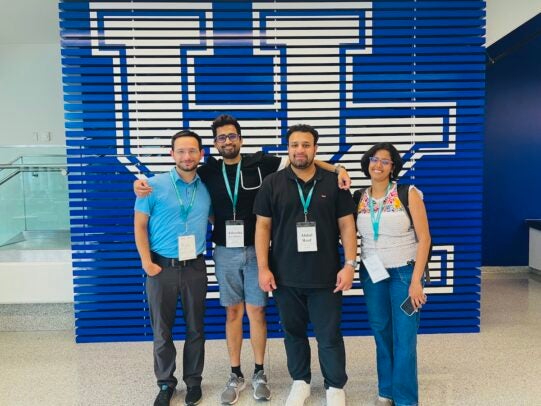UIC student presents research on chemistry education at national conference
University of Illinois Chicago PhD student Abdul Rauf presented his work on new collaborative and student-centered approaches to teaching chemistry at a national conference on chemistry education this summer.
The Biennial Conference on Chemical Education is organized by the American Chemical Society’s Division of Chemical Education. Rauf, working under the supervision of Minjung Ryu, delivered two presentations.

In his first presentation, “Engaging College Chemistry Faculty in Collaborative Action Research for Professional Development,” Rauf shared the research he conducted as part of a National Science Foundation-funded project: Institutional Transformation through Curriculum and Faculty Development to Serve the Modern Chemistry Student.
The project is led by principal investigator Donald Wink, with the Collaborative Action Research (CAR) component spearheaded by Ryu, while Rauf contributes as a graduate research assistant. Rauf highlighted the Collaborative Action Research projects conducted with three distinct instructional teams in the UIC Department of Chemistry between spring 2023 and spring 2024.
“Our approach with CAR is all about collaboration,” Rauf said. “It’s about bringing educators together to reflect, identify problems, implement evidence-based practices and assess the impact through data collection and analysis. Our collaboration has included a diverse group of instructors, including a graduate teaching assistant, tenured faculty members and non-tenure track faculty members.” he said.
In addition to covering the collaborative aspect, Rauf’s presentation delved into the process of implementing Collaborative Action Research within a higher education setting.
“We also examine the outcomes, challenges and best practices related to CAR. We collect data through multiple sources, including reflection journals, field notes, audio and video recordings of CAR meetings and exit interviews with participating instructors. The study’s implications extend beyond its immediate context, offering insights into the implementation of CAR in higher-education settings,” Rauf said.
The presentation showcased preliminary findings from his research, which indicate that Collaborative Action Research enhances instructors’ professional growth, reflective teaching practices, sense of ownership and ability to address immediate issues in their classrooms. Moreover, Collaborative Action Research has contributed to fostering a culture of collaboration and shared inquiry within the department.
Rauf’s second presentation, “Beyond Arrows: Organic Chemistry Students’ Understanding of Electron Pushing Formalism as Scientific Modeling“ highlighted his independent research project.
“I am particularly interested in investigating how students use representations in unintentional yet meaningful ways to understand complex phenomena, such as chemical reactions, and how this aids in problem-solving within the subject,” Rauf said.
Drawing on the theoretical frameworks, Rauf emphasized the importance of placing students at the center of the learning process. He critiqued the traditional “model of” approach, where models are viewed as static representations, and advocated for a “model for” perspective. This shift positions models as active tools in problem-solving, allowing students to achieve their epistemic goals.
The presentation showcased preliminary findings from his research, revealing that students often use representations in unintentional yet meaningful ways and how they conceptualize and use scientific models to understand and elaborate on organic chemistry reactions. These insights hold significant implications for improving the teaching of modeling in organic chemistry, with the potential to reduce the notoriously high rates of letter grades D, F and withdrawal that challenge students in this subject.
Rauf’s research not only aims to enhance student outcomes but also aligns with national priorities to increase retention in STEM disciplines, further solidifying the United States’ leadership in global STEM education.
